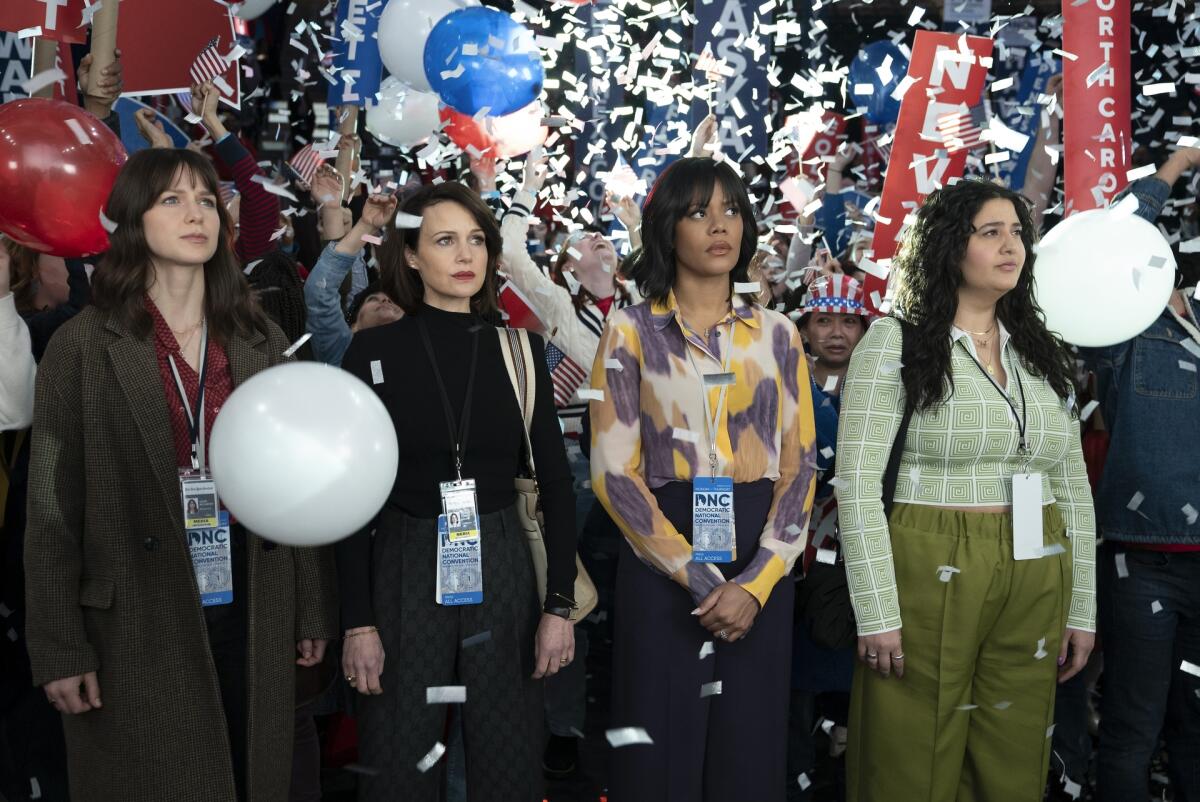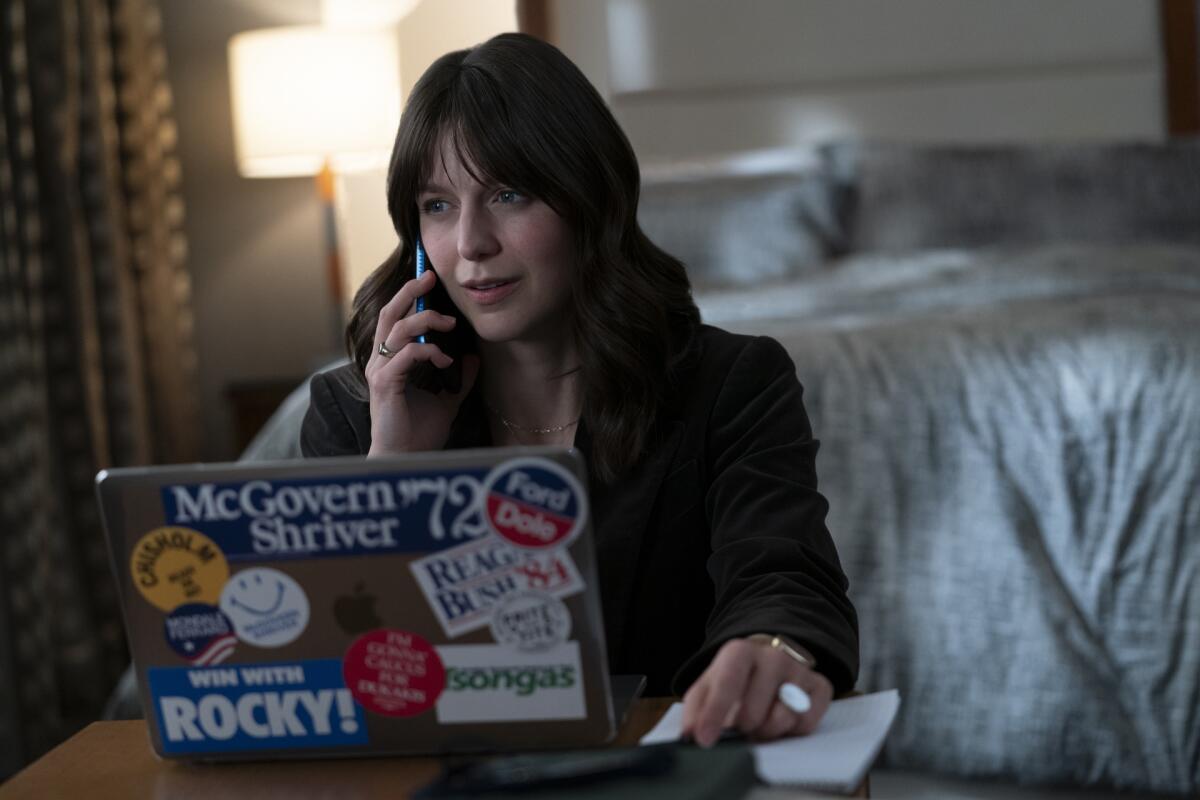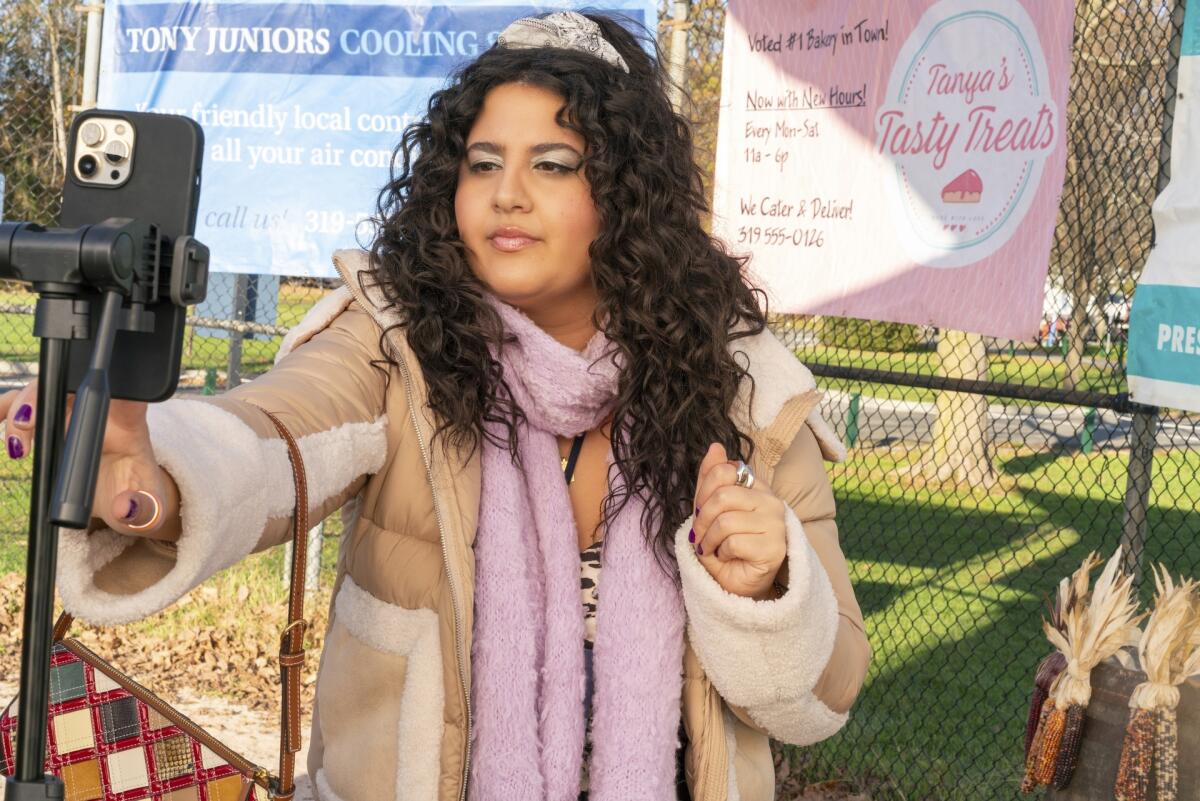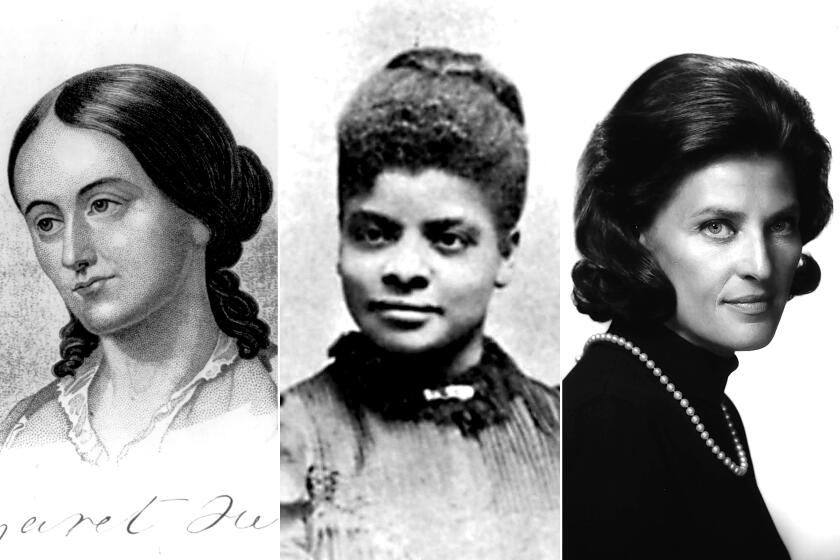How ‘The Girls on the Bus’ depicts journalists would be fun, if it weren’t so dangerous

- Share via
Just as the country prepares for what promises to be one of the uglier and most historically significant presidential election cycles, Max is gifting us with “The Girls on the Bus.” Inspired by Amy Chozick’s 2018 book “Chasing Hillary: Ten Years, Two Presidential Campaigns and One Intact Glass Ceiling,” it follows four women as they cover a fictional primary for a wide variety of outlets. (Warning: An influencer is involved.)
As the title would indicate, it aspires to be something of a fem-centric version of Timothy Crouse’s classic 1973 portrait of campaign-trail journalists, “The Boys on the Bus,” with bits of Hunter S. Thompson’s “Fear and Loathing: On the Campaign Trail ’72” thrown in. (Indeed, Thompson, who died in 2005, is an actual, and quite irritating, character here.)
Instead what emerges is a manic-pixie-dream-Grrrl Power drama in which all the women rush about in a cloud of charger cords, vibrators, Twizzlers and barely packed suitcases, apparently too overwhelmed by stonewalling press secretaries, conniving colleagues and their own backstories to file anything like the regular coverage this job requires.
Also, the two who work for newspapers are more concerned with front-page placement in print than page views or social media plans, which is just adorable. All of this would be fine if it weren’t for the underlying, and clearly inadvertent, message that female journalists are more interested in mining their own psyches than doing their jobs.
Brooke Kroeger’s ‘Undaunted: How Women Changed American Journalism’ tracks the slow and incomplete progress of women in the newsroom and out in the field.
Though festooned with drive-by references to all manner of big issues — double standards, authenticity versus impartiality, cancel culture — the series focuses on the reporters’ emotional relationships. Jamming in as many iterations of these as one can possibly think of, along with an emerging follow-the-money mystery and the obligatory campaign trail hookups, “The Girls on the Bus” looks more like the love child of “Scandal” and “The Sex Lives of College Girls” than any of the above-mentioned books, including Chozick’s.
It is no doubt tonally intentional, but still a bit weird considering how many details, including references to some of her actual pieces and bits of dialogue, have been lifted directly from “Chasing Hillary.” Chozick, along with Julie Plec (“The Vampire Diaries”), created and wrote the series, which bounced from Netflix to the CW before landing at Max, and a distinct CW flavor (Greg Berlanti is one of the producers) lingers.

“Supergirl’s” Melissa Benoist plays the lead (and Chozick stand-in), one Sadie McCarthy. A New York Sentinel reporter whose “conversations” with Thompson red-flag the show’s fraught yet frothy tone, Sadie’s reputation suffered during the previous presidential campaign, after the female candidate she had been covering lost. Sadie’s tears went viral as a symbol of journalistic bias.
When her editor, played by Griffin Dunne, assigns her to cover the elderly male candidate in this race, Sadie stomps her foot and convinces him that she has learned her lesson and can be trusted to impartially report on the female front-runner.
I don’t know how things work at the Sentinel, but this seems to be a rather haphazard, and last-minute, way of planning political coverage. But then, Dunne’s character, with a signature scarf, many cigarettes and endless tough-love encouragement, seems based on “Chasing Hillary’s” depiction of the late, lamented New York Times columnist David Carr more than any actual political editor who has ever lived.
And I honestly don’t know how to categorize any series in which a journalist talks about memes while smoking indoors. Was there a space-time continuum glitch that I missed?
In any case, the decision allows Sadie to quickly be reunited with Grace (the always magnificent Carla Gugino), an older, wiser (a.k.a. tough-talking) journalistic icon from a competing paper (one assumes the Washington Post) who is known for getting scoops even, apparently, on the campaign trail. Together, they roll their eyes at the entrances of Kimberlyn (Christina Elmore), reporting for a conservative cable station, and Lola (Natasha Behnam, who steals every scene she’s in), a sponsor-courting influencer who openly supports an Alexandria Ocasio-Cortez-like candidate.
Of course the four of them, all women questioning at one level or another the ability to remain truly impartial about anything and the cost such a demanding profession imposes on their backstories, er, lives, will soon become besties.

Relationships, not reporting, drive “The Girls on the Bus,” which is surprising because Chozick knows better than anyone how long and hard women have had to fight to be taken seriously as journalists (in “The Boys on the Bus,” Crouse describes the few women covering the campaign as “pretty” or “plain”).
Obviously, a show in which the main character talks to a long-dead journalist is not going for the same tone, or audience, as, say, “The Wire.” But it would have been nice if “The Girls on the Bus” had depicted its chosen milieu in a less soap-operatic way, especially if at least part of the point was to chronicle the actual demands of campaign-trail journalists and/or restore faith in the press during an election year.
Instead, every episode of “The Girls on the Bus” is to campaign reporting what the Izzy-kills-Denny-to-get-him-a-new-heart-and-then-sees-his-ghost storyline of “Grey’s Anatomy” was to the medical profession. That may draw a certain type of audience, and I admire anyone who attempts to make a television show about journalists because it is such a visual and narrative challenge.
With television anchors, a la “The Newsroom” and “The Morning Show,” there is at least a bit of glamour and the bustle of a TV studio baked in. But the business of actual reporting? Let’s just say that the most accurate cinematic visual of a reporter’s job remains the scene in “All the President’s Men” when Woodward and Bernstein are sifting through every request the White House made of the Library of Congress for an entire year. And even that scene depends on a magnificent overhead pullback, accentuating the symbolic rings within rings of the building’s historic reading room, to make it interesting.
Whether the series’ look at our #MeToo moment works is debatable. But its combination of personal drama and topical satire is definitely fun to watch.
No matter how explosive the pursued story may be, the actual work of newsgathering and production is visually repetitive and often silent. “The Boys on the Bus” illuminated many of the (almost all male) personalities involved in covering the 1972 Democratic primary and subsequent race between George McGovern and then-President Richard Nixon, but it served mostly as a highly analytical indictment of pack journalism, in which a welter of reporters are required to report daily on the same series of often not-very-significant events. Not only did Crouse believe that the pack mentality resulted in a “missed the forest for the trees” situation, but he also suggests that a mostly liberal press felt obligated to be harder on McGovern than on Nixon.
In her book, Chozick also questions the ability to remain impartial, and insightful, while being part of a pack, as she does more obviously in “The Girls on the Bus.” But when Chozick was one of those “girls,” she also managed to file stories daily, often more than one.
The other challenge facing a show about journalists is, as I am now proving, that it will be first critiqued by actual journalists. As Aaron Sorkin discovered with “The Newsroom,” critics and columnists, who happily laud dramas in which the doctors, lawyers, educators and even mobsters behave in ways that no actual member of their profession ever would, tend to gleefully jump on any real or perceived inaccuracy of how a reporter does her job and tear the show to pieces.
So I did try, very hard, to view “The Girls on the Bus” for what it is: a television show, designed to entertain, rather than a docudrama created to inform. And there are many entertaining moments, a few thought-provoking subplots and a fine evocation of how exhausting it is to be shuttled from state to state to cover candidates who monotonously refuse to grant interviews.
If only it didn’t make everyone involved in maintaining a free and informed democracy look so damn silly. In a year when the presumed Republican candidate is up to his eyeballs in legal trouble and doubling down on his previous attempt to overthrow a legal and fair election, when he and his supporters have helped lower the country’s faith in the press and multiple news platforms have experienced catastrophic layoffs, fraught ’n’ frothy might not have been the way to go.
More to Read
The complete guide to home viewing
Get Screen Gab for everything about the TV shows and streaming movies everyone’s talking about.
You may occasionally receive promotional content from the Los Angeles Times.








